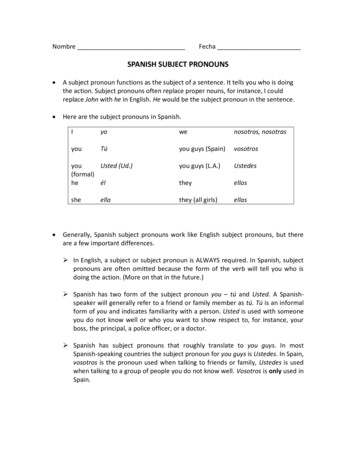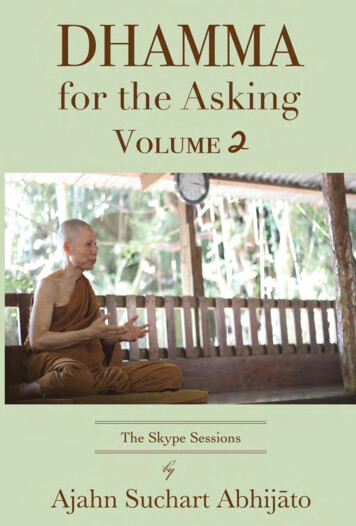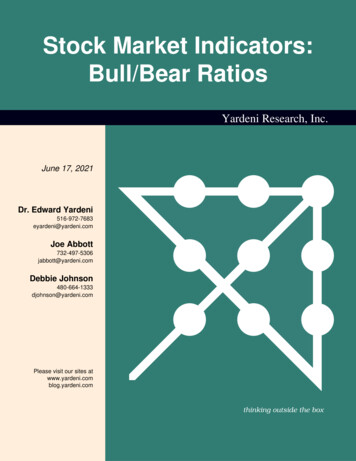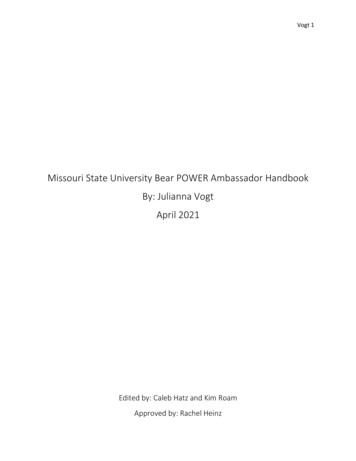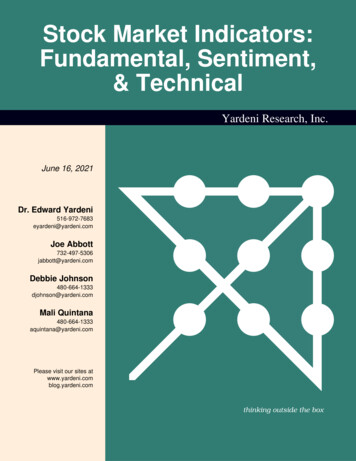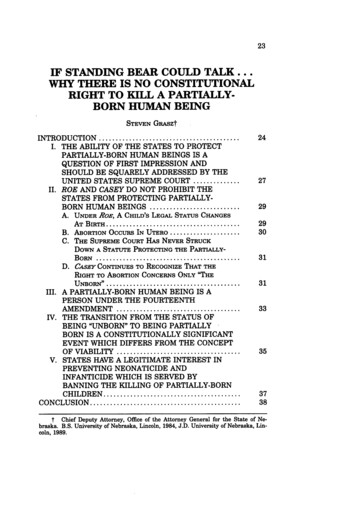
Transcription
IF STANDING BEAR COULD TALK.WHY THERE IS NO CONSTITUTIONALRIGHT TO KILL A PARTIALLYBORN HUMAN BEINGSTEVEN GRAsztINTRODUCTION .I. THE ABILITY OF THE STATES TO PROTECTPARTIALLY-BORN HUMAN BEINGS IS AQUESTION OF FIRST IMPRESSION ANDSHOULD BE SQUARELY ADDRESSED BY THEUNITED STATES SUPREME COURT .II. ROE AND CASEY DO NOT PROHIBIT THESTATES FROM PROTECTING PARTIALLYBORN HUMAN BEINGS .242729A.UNDER ROE,AAT BIRTH .29B.ABORTION OCCURS IN UTERO .30C.THE SUPREME COURT HAS NEVER STRUCKCHILD'S LEGAL STATUS CHANGESDOWN A STATUTE PROTECTING THE PARTIALLY-B ORND.31CASEY CONTINUES TO RECOGNIZE THAT THERIGHT TO ABORTION CONCERNS ONLY "THEUNBORN .III. A PARTIALLY-BORN HUMAN BEING IS APERSON UNDER THE FOURTEENTHAMENDMENT .IV. THE TRANSITION FROM THE STATUS OFBEING "UNBORN" TO BEING PARTIALLYBORN IS A CONSTITUTIONALLY SIGNIFICANTEVENT WHICH DIFFERS FROM THE CONCEPTOF VIABILITY .V. STATES HAVE A LEGITIMATE INTEREST INPREVENTING NEONATICIDE ANDINFANTICIDE WHICH IS SERVED BYBANNING THE KILLING OF PARTIALLY-BORNCH ILDREN .CONCLU SION .t3133353738Chief Deputy Attorney, Office of the Attorney General for the State of Ne-braska. B.S. University of Nebraska, Lincoln, 1984, J.D. University of Nebraska, Lin-coln, 1989.
CREIGHTON LAW REVIEW[Vol. 33INTRODUCTIONIn 1868, a government official attempted to justify the killing ofNative American children by the U.S. military by stating that "[n]itsmake lice."' It was not until 1879 that a federal court held, in thehistoric case of United States ex rel. StandingBear v. Crook,2 that Native Americans were "persons" for purposes of federal law. Now, 120years later, some of the same legal arguments that were made in anattempt to deny civil rights protection to Standing Bear and other Native Americans are once again being made to deny legal protection toother vulnerable human beings. This time, the victims are partiallyborn children, delivered up to their head and dangling just inchesfrom complete independence. Once again, the threshold legal issuewhich must be addressed is whether such children are "persons" forpurposes of federal law.In the mid and late 1990s, the United States Congress and themajority of state legislatures separately addressed a growing publicconcern regarding the controversial medical procedure legally denominated as "partial-birth abortion," and now known medically as "D&X"abortion or "intact D&E" abortion. Legislators across the countrywere so repulsed by the procedure that twenty-seven states and theUnited States Congress passed statutory bans on partial-birth abortion.3 As one federal court described it, the partial-birth abortion/D&X procedure "is gruesome and inhumane." 4 More specifically, theprocedure is described as follows:When the fetus is presented feet first, [the physician], usingforceps, pulls the feet of the living fetus from the uterus intothe vaginal cavity-and then pulls the remainder of the fetus,except the head, into the vaginal cavity to a point where thebase of the fetal skull is lodged in the uterine side of the cervi1. DEE BROWN, BURY My HEART AT WOUNDED KNEE 90 (1970) (quoting ColonelJohn M. Chivington).2. 25 F. Cas. 695, 697 (C.C.D. Neb. 1879) (No. 14891).3. States passing statutory bans on partial birth abortion include: Michigan(1996); South Dakota (1997); Mississippi (1997); Georgia (1997); South Carolina (1997);Arkansas (1997); Arizona (1997); Montana (1997); Alaska (1997); Indiana (1997); Alabama (1997); Nebraska (1997); Tennessee (1997); Rhode Island (1997); Louisana (1997);Illinois (1997); New Jersey (1997); Iowa (1998); Florida (1998); Idaho (1998); West Virginia (1998); Virginia (1998); Kentucky (1998); Oklahoma (1998); Wisconsin (1998);North Dakota (1999); and Missouri (1999). The 104th U.S. Congress passed the PartialBirth Abortion Ban Act on March 27, 1996. The act was vetoed by President Clinton onApril 10, 1996. The House voted to override the veto, 285-137, but the Senate vote wasshort of the needed 2/3 majority. The 105th Congress passed the Partial-Birth AbortionBan Act on October 8, 1997. President Clinton vetoed the act on October 10, 1997. TheHouse again voted to override the veto (296-132), but the Senate failed to override theveto by a margin of three votes (64-36) on September 18, 1998.4. Evans v. Kelley, 977 F. Supp. 1283, 1319 n.38 (E.D. Mich. 1997). Even someabortion practitioners believe it "is a particularly hideous procedure." Id.
1999]IF STANDING BEAR COULD TALKcal canal. At that point, the size of the head will not permithim to pull it through the cervical canal into the vaginal cavity. To decompress the fetal skull and evacuate the contentsin order to pull it through the cervical canal, [the physician]uses an instrument to either tear or perforate the skull to allow insertion of a cannula and removal of the cranial5contents.One nurse who actually observed the D&X procedure stated:I have been a nurse for a long time, and I have seen a lot ofdeath - people maimed in auto accidents, gunshot wounds,you name it. I have seen surgical procedures of every sort.But in all my professional years, I had never witnessed any6thing like this.She described its effect on a partially-born child as follows:[The physician] brought the ultrasound in and hooked it up sothat he could see the baby. On the ultrasound screen, I couldsee the heart beat. As [the doctor] watched the baby on theultrasound screen, the baby's heartbeat was clearly visible onthe ultrasound screen.[The doctor] went in with the forceps and grabbed the baby'slegs and pulled them down into the birth 'canal. Then he delivered the baby's body and the arms - everything but thehead. The doctor kept the head right inside the uterus.The baby's little fingers were clasping and unclasping, andhis little feet were kicking. Then the doctor stuck the scissorsin the back of his head, and the baby's arms jerked out, like astartle reaction, like a flinch, like a baby does when he thinkshe is going to fall.The doctor opened up the scissors, stuck a high-poweredsuction tube into the opening, and sucked the baby's brainsout. Now the baby went completely limp.I was really completely unprepared for what I was seeing. Ialmost threw up as I watched [the doctor] doing these things.Next, [the doctor] delivered the baby's head. He cut theumbilical cord and delivered the placenta. He threw the babyin a pan, along with the placenta and the instruments he had5. Carhart v. Stenberg, 11 F. Supp. 2d 1099, 1106 (D. Neb. 1998) (citations omitted), affd, 192 F.3d 1142 (8th Cir. 1999), petition for cert. filed, No. 99-830 (U.S. Nov. 15,1999).6. PartialBirth Abortion Ban: Hearing on HR 1833 Before the Senate JudiciaryCommittee, 104th Cong. 18 (1995) (statement of Brenda Pratt Shafer, R.N.). This procedure is not common, compared to the D&E procedure. However, Dr. LeRoy Carhart, aBellevue, Nebraska, abortion practitioner, testified at trial that he attempts to performthe procedure on every unborn child he aborts after 16 weeks gestation.
CREIGHTON LAW REVIEW[Vol. 33just used. I saw the baby move in the pan. I asked anothernurse, and she said it was just reflexes.The woman wanted to see her baby, so they cleaned up thebaby and put it in a blanket and handed it to her. She criedthe whole time. She kept saying, "I am so sorry, please forgive me." I was crying too. I couldn't take it. That baby boyhad the 7most perfect angelic face I think I have ever seen inmy life.Despite the unprecedented public outcry against this procedure(from both "pro-life" and many "pro-choice" legislators, doctors and citizens),8 most of the state partial-birth abortion statutes have sincebeen enjoined or declared unconstitutional. 9 Many of these cases remain in the courts at various stages of litigation or appeal. Due to thenumber of cases making their way through the courts, and due to several minority decisions upholding partial-birth abortion bans, it isquite possible the validity of the state statutes will ultimately be decided by the United States Supreme Court. 10 This article will focus ona threshold constitutional issue, heretofore largely avoided by thelower courts, which should be squarely addressed by the Court in anyreview of state partial-birth abortion statutes. That issue is whetherthe legal framework established in Roe v. Wade," and its progeny,applies to a child which is more outside the uterus than inside. Inother words, is there a constitutional right to kill a partially-bornhuman being - or are partially-born children entitled to the protectionof the Fourteenth Amendment?The article will explain why partial-birth abortion cases can, andshould, be decided outside the legal framework of Roe and its progeny,based on the legal classifications concerning personhood created inRoe itself. The right of a mother to abort her child applies, according7. Id.8. Many partial-birth abortion statutes have been passed by overwhelming majorities of both pro-life and pro-choice legislators. For example, Nebraska's statute passedwith only one dissenting vote. Nebraska Legislative Journal, 95th Leg., 1st Sess. 2609(1997) (record of final vote on LB 23). The federal Partial Birth Abortion Ban Act received the support of over two-thirds of the members of the U.S. House in 1996 andagain in 1997. Teresa R. Wagner, The Partial-BirthAbortion War, THE WORLD AND I,88-89 (Sept. 1999).9. See, e.g., Carhart v. Stenberg, 192 F.3d 1142 (8th Cir. 1999) (listing numerousdecisions of federal district courts), petition for cert. filed, No. 99-830 (U.S. Nov. 15,1999).10. Nebraska's partial-birth abortion statute was the first to be reviewed at theCircuit Court level. The Eighth Circuit upheld the lower court's decision invalidatingthe Nebraska statute as well as other lower courts' decisions invalidating the Arkansasand Iowa partial-birth abortion statutes.11. 410 U.S. 113 (1971).
1999]IF STANDING BEAR COULD TALKto Roe, only to "the unborn." Thus, on its face, abortion jurisprudenceis limited in applicability to children in utero. The evidence presentedin partial-birth abortion cases nationwide makes it clear that the partial-birth abortion/D&X procedure involves a child more outside of theuterus than inside. 12 Since there is no Supreme Court precedent13preventing the States from protecting partially-born human beings,courts need not, and should not, apply the framework articulated in14Roe and PlannedParenthoodof Southeastern Pennsylvania v. Caseyto partial-birth abortion statutes.As discussed below, partial birth places a child in a legal statussuperior to that of mere chattel. Given that partial-birth abortioncases present an issue involving life and death, and given the states'judicially-recognized interest in fetal life even prior to partial birth,the Court should not place partially-born human beings in the samecategory as "the unborn" for purposes of reviewing state statutes regulating the partial-birth abortion procedure.I.THE ABILITY OF THE STATES TO PROTECT PARTIALLYBORN HUMAN BEINGS IS A QUESTION OF FIRSTIMPRESSION AND SHOULD BE SQUARELY ADDRESSEDBY THE UNITED STATES SUPREME COURTLower federal courts are obliged to follow clear legal precedentregardless of whether it may seem unwise or even morally repugnantto do so. However, a court need not extend questionable jurispru12. One court noted in its preliminary injunction memorandum that there was noevidence establishing whether the child undergoing a partial-birth abortion was in the"birth" process. Carhart v. Stenberg, 972 F. Supp. 507, 529 n.35 (D. Neb. 1997). However, a state need not establish that fact. A state need only show that the child is not'unborn" or in utero. Planned Parenthood of Southeastern Pennsylvania v. Casey, 505U.S. 833, 913 (1992) (Stevens, J., concurring in part and dissenting in part). Nationwide, the evidence has clearly established that the procedure in question is not performed on a child in utero, but rather on a child protruding all but inches from completeexpulsion. As one plaintiff abortionist admitted, during D&X or "intact D&E" abortionsthe abortionist "extracts the fetal body intact, usually feet first, until the cervix is obstructed by the after-coming head, which is too large to pass through the cervix." Carhart, Complaint at 30, Carhart v. Stenberg, 972 F. Supp. 507 (D. Neb. 1997) (No. 4:97CV3205). Thus, it is clear that the child is mostly outside of the womb. Therefore, thechildren involved are in a different situation than the "unborn." It is not necessary forthe State to prove any more than this to distinguish the case from Roe v. Wade, 410 U.S.113 (1973) and its progeny. Nonetheless, the medical evidence does show that the challenged procedure involves induced uterine contractions followed by a breech delivery,and thus a birth process. Carhart v. Stenberg, 11 F. Supp. 2d 1099, 1105 (D. Neb. 1998)("The AMA report describes the intact D&X as 'deliberate dilation of the cervix, usuallyover a sequence of days; instrumental conversion of the fetus to a footling breech; breechextraction of the body excepting the head.'"), affd, 192 F.3d 1142 (8th Cir. 1999), petition for cert. filed, No. 99-830 (U.S. Nov. 15, 1999).13. Carhart,972 F. Supp. at 529.14. 502 U.S. 833 (1992).
CREIGHTON LAW REVIEW[Vol. 33dence into new areas or apply it in areas outside of where there isclear precedent. 15 This is especially true when a federal court is reviewing the validity of a state statute.As one federal court has noted, "there is no precedent" regardingthe treatment of the partially born as persons.' 6 Therefore, this question is a matter of first impression. In such cases, basic principles offederalism as well as the Supreme Court's admonitions in Casey favordeference towards a state's legislative judgment. As the Court emphasized in Casey, the states' interests in preserving human life have not,heretofore, been given due regard by the lower courts. 17 Since there isno precedent prohibiting States from protecting partially-born humanbeings, it is appropriate to defer to a state's legislative determinationrather than the wishes of the most extreme elements of the abortionindustry. As shown by the following examples, courts have faced similar questions throughout the history of the development of civil rightsin the United States.In 1856, the United States Supreme Court held that a "free negroof the African race, whose ancestors were brought to this country andsold as slaves, is not a 'citizen' within the meaning of the Constitutionof the United States" and "the special rights and immunities guaranteed to citizens do not apply to them."' 8 This infamous decision waseventually overturned by the blood of thousands on the battlefields ofthe Civil War. Despite the ratification of the Fourteenth Amendmentin 1868, the treatment of some individuals as "nonpersons" persistedin the courts. In fact, Native Americans were not recognized as "persons" under the laws of the United States until 1879.19In 1973, the United States Supreme Court held that notwithstanding "the well-known facts of fetal development," the "unborn" arenot "persons" under the Fourteenth Amendment. 20 The result hasbeen that more than one out of every four American children conceived since 1973 have been aborted, most for purely elective21reasons.Now courts are faced with the question of whether partially-bornhuman beings, delivered three-fourths outside of the womb, are "per15. See, eg., Washington v. Glucksberg, 521 U.S. 702 (1997).16. Carhart,972 F. Supp. at 529.17. See generally Planned Parenthood of Southeastern Pennsylvania v. Casey, 505U.S. 833 (1992).18. Dred Scott v. Sandford, 60 U.S. (19 How.) 393, 393 (1856) (from syllabus I, 4, 5,6).19. United States ex rel. Standing Bear v. Crook, 25 F. Cas. 695, 697 (C.C.D. Neb.1879) (No. 14891).20. Roe v. Wade, 410 U.S. 113, 155, 162 (1973).21. Statistical Abstract of the United States, U.S. Bureau of the Census 117th ed.83 (1997).
1999]IF STANDING BEAR COULD TALKsons" under the Fourteenth Amendment. In a preliminary injunctionmemorandum, one federal court brushed this issue aside by notingthat "there is no precedent" for treating partially-born human beingsas persons. 2 2 Amazingly, this is, in essence, the same argument madeby the federal authorities in support of denying civil rights protectionto Standing Bear and thirty-five other Native Americans in April of1879 - exactly 119 years previous - in the same court. In StandingBear,2 3 Federal District Judge Elmer S. Dundy expressly addressedand rejected this argument:I must hold, then, that Indians, and consequently the relators, are "persons," such as are described by and includedwithin the laws before quoted. It is said, however, that this isthe first instance on record in which an Indian has been permitted to sue out and maintain a writ of habeas corpus in afederal court, and therefore the court must be without jurisdiction in the premises. This is a non sequitur. I confess I donot know of another instance where this has been done, but Ican also say that the occasion for it perhaps has never before24been so great.The fact that there is no clear precedent regarding the status ofpartially-born children does not mean a court must conclude that theyare without constitutional protection. 2 5 The United States SupremeCourt should refuse to add partially-born human beings to the infamous list of those considered "nonpersons."II.ROE AND CASEY DO NOT PROHIBIT THE STATES FROMPROTECTING PARTIALLY-BORN HUMAN BEINGSA.UNDERRoE, ACHILD'S LEGAL STATUS CHANGES AT BIRTHAlthough the arbitrary and unscientific trimester framework ofRoe was discarded by the courts years ago, 2 6 Roe nonetheless remainsinstructive on certain points of abortion law. It is clear that evenunder the more restrictive framework applied in Roe, which theSupreme Court in Casey said failed to give proper weight to the states'22. Carhart v. Stenberg, 972 F. Supp. 507, 529 (D. Neb. 1997).23. 25 F. Cas. 695 (C.C.D. Neb. 1879) (No. 14891).24. United States ex rel. Standing Bear v. Crook, 25 F. Cas. 695, 697 (C.C.D. Neb.1879) (No. 14891).25. StandingBear, 25 F. Cas. at 697 (No. 14891). See Metropolitan Life Ins. Co. v.Ward, 470 U.S. 869, 881 n.9 (1985) (noting that "a corporation is a 'person' within themeaning of the Fourteenth Amendment").26. Planned Parenthood of Southeastern Pennsylvania v. Casey, 505 U.S. 833, 873(1992).
CREIGHTON LAW REVIEW[Vol. 3327Ininterests, a child's legal status changes dramatically at birth.short, the Court has arbitrarily chosen birth, not viability, as thethaumaturgical moment when a child gains the constitutional statusof personhood. Consequently, it is of great significance that a child inparturition is not "unborn," and that the Court has never recognized aconstitutional right to kill a partially-born human being.B.ABORTION OCCURS IN UTEROAbortion jurisprudence is, to a significant extent, a word game. Ina legal context where a child is a non-person one minute and a personthe next, terminology and definitions are of critical importance. Inthis light, it is clear that the killing of partially-born children is inherently different from a true abortion. Abortion is typically defined as2928which occurs "within the uterus."the termination of a pregnancy,30"ChildHowever, pregnancy differs from parturition or childbirth.31birth is defined as 'parturition,' '[t]he act of giving birth.'" Thus, recognition of a heightened legal status for a partially-born child is notinconsistent with either Roe or Casey because the right to chooseabortion, recognized in Roe and Casey, applies only with respect to"the unborn."3 2 A child who is partially outside his or her mother cannot properly be termed "unborn." During the typical partial-birthabortion procedure as described by practitioners, the child is threefourths born. Only a few inches of the child could arguably be said toThus, the child, as a whole, is partially-born, notbe "unborn.""unborn."3 327. Roe v. Wade, 410 U.S. 113, 160-63 (1973) ("until live birth"; "before live birth";"upon live birth"; "born alive"; "Perfection of the interests involved. has generallybeen contingent upon live birth.").28. See, e.g., NEB. REV. STAT. § 28-326(1) (1995).29. McNill v. New York City Dept. of Corrections, 950 F. Supp. 564, 569 (S.D.N.Y.1996) (citations omitted).30. See, e.g., Kirkhuff v. Nimmo, 683 F.2d 544, 549 (D.C. Cir. 1982).McNill, 950 F. Supp. at 569 (quoting WEBSTER'S II NEW RIVERSIDE UNIVERSITY(1994)).32. Planned Parenthood of Southeastern Pennsylvania v. Casey, 505 U.S. 833, 913(1992) (Stevens, J., concurring in part and dissenting in part).33. This is really a matter of common sense. No rational person using commonsense would describe a child delivered up to its neck as "unborn." Black's Law Dictionary defines "born" as the "[aict of being delivered or expelled from mother's body,whether or not placenta has been separated or cord cut." BLAcK's LAw DICTIONARY 167(5th ed. 1979). This definition presents a logical conundrum for those who argue thatthe child is "unborn" until completely expelled, since the placenta and umbilical cordare, in their legal framework, equal in significance with the head. They are all "products of conception" which are merely medical waste and not parts of a person.31.DICTIONARY 255, 858
1999]C.IF STANDING BEAR COULD TALKTHE SUPREME COURT HAS NEVER STRUCK DOWN A STATUTEPROTECTING THE PARTIALLY-BORNIt is true that the status of a partially-born child is a gray area notyet clearly determined by the Supreme Court. Thus far, however, theCourt has left protection in place for the partially-born. In Roe, theCourt noted that a Texas statute, which prohibited killing a partiallyborn child, was not challenged. The Court set out the statute, whichprovides: "Whoever shall during parturition of the mother destroy thevitality or life in a child in a state of being born and before actualbirth, which child would otherwise have been born alive, shall be confined in the penitentiary for life or for not less than five years."3 4 TheTexas parturition homicide statute is still on the books today,3 5 and38has been found to be good law subsequent to Roe.D.CASEY CONTINUES TO RECOGNIZE THAT THE RIGHT TO ABORTIONCONCERNS ONLY "THE UNBORN"Justice Stevens, in the crucial portion of his partial concurrenceand partial dissent in Casey, noted that:The Court in Roe carefully considered, and rejected, theState's argument "that the fetus is a 'person' within the language and meaning of the Fourteenth Amendment." Afteranalyzing the usage of [the word] "person" in the Constitution, the Court concluded that the word "has application onlypostnatally." . "In short, the unborn have never been recog37nized in the law as persons in the whole sense."38This "fundamental premise" underlying abortion jurisprudenceis directly at issue in cases challenging partial-birth abortion statutes.As Justice Stevens noted, "live birth" triggers perfection of the unbornchild's legal personhood. While "unborn," a child may still be legallykilled to preserve the life, and possibly the "health," of the mothereven after viability.3 9 Thus, partial live-birth is a constitutionally sig34. Roe v. Wade, 410 U.S. 113, 118 n.1 (1973). "Parturition" is "the action or process of giving birth to offspring." WEBSTER'S NINr NEW COLLEGIATE DIcTIoNARY 859(1985).35. TEX. Civ. STAT. ANN. art. 4512.5 (West 1976).36. See Showery v. State, 690 S.W.2d 689, 692 (Tex. App. 1985); Tex. Att'y Gen.Op. No. H-369 (1974) (The statute "is not, in truth, an abortion statute."). Id. at 3.37. Casey, 505 U.S. at 913 (Stevens, J., concurring in part and dissenting in part)(discussing the principles underlying abortion jurisprudence) (citations omitted). Justice Stevens went on to quote Roe's foundational premise that "[plerfection of the interests involved. has generally been contingent upon live birth." Id. (quoting Roe, 410U.S. at 162) (emphasis added).38. Casey, 505 U.S. at 914 (Stevens, J., concurring in part and dissenting in part).39. It is important to remember that viability and personhood are two distinctlegal concepts. A child becomes a person under the Fourteenth Amendment at birth regardless of "viability."
CREIGHTON LAW REVIEW[Vol. 33nificant event. Since legal personhood "has applicationpostnatally,"40 the passage of the child partly outside the womb is anevent which differentiates the legal status of the child from one whichhas not left the womb. Therefore, a child which is all but a few inchesfrom completing birth is no longer "unborn."Consistent with Roe, the Casey decision recognizes the legitimateinterests of the states "in the health of the woman and in protectingthe potential life within her."4 1 Once a child is partially, if not mostly,outside the mother's body, she can no longer be correctly classified as"within [the mother] ."42 The passage of the child partly, i.e., all but afew inches, outside the womb has great legal significance since"Roe .may be seen., as a rule., of personal autonomy and bodilyintegrity."4 3 A woman's interest in "personal autonomy and bodily integrity" is compromised and diminished once the child is partiallyoutside the woman's body. For example, in some states, even understate law prior to the enactment of partial-birth abortion statutes, itwas a criminal offense to kill a child that was delivered outside themother, but still connected to the umbilical cord and undelivered placenta remaining within the mother. 44 The difference between partialbirth abortion and murder, therefore, is literally mere inches.Some may argue that personhood only attaches when the child iscompletely extracted from the mother. However, that is not what Roesaid. Roe said that the "unborn" are not persons. Those who are partially born are no longer "unborn." Therefore, the act of delivering allbut a few inches of a child before killing it has constitutional implications. That child is no longer "unborn" but is partially born and atleast partially, if not completely, clothed in personhood. This mayseem semantical. However, as noted above, abortion jurisprudence isbased on definitions and arbitrary distinctions. It must beremembered that the States did not arbitrarily condemn "the unborn"to persona non grata status with respect to the Fourteenth Amendment. The States are entitled to use and rely on the exact line of demarcation established by the Court.40. Casey, 505 U.S. at 913 (Stevens, J., concurring in part and dissenting in part).41. Id. at 871 (emphasis added).42. Id. See Floor Debate LB 23, 95th Leg. 1st Sess. 58R (Neb. June 3, 1997) (statement of Sen. Pam Brown) (stating "there are some issues about this procedure thatchallenge even those of us who believe in a woman's right to choice . at least part ofthe fetus is outside the uterus . . .43. Casey, 505 U.S. at 857.44. See, e.g., NEB. REV. STAT. § 28-331 (Reissue 1995) (statute requiring attendingphysician performing an abortion to preserve the life any child born alive, regardless ofgestational age, even where placenta and umbilical cord are still attached and remaining inside the mother). Again, this presents a conundrum for those who insist a child is"unborn" until completely expelled since, under their legal framework, the placenta islegally indistinguishable from the head as both are mere products of conception.
1999]IF STANDING BEAR COULD TALKIn sum, the rules and legal tests set forth in Casey and Roe haveapplication only to "the unborn," and do not govern state protection ofa partially-born child. Therefore, to sustain a ban on killing a partially-born human being, a State need only have a rational basis forthe prohibition. A ban on partial-birth abortions is rationally relatedto-a number of legitimate state interests which have been described in45detail by the courts.III.A PARTIALLY-BORN HUMAN BEING IS A PERSONUNDER THE FOURTEENTH AMENDMENTThe Fourteenth Amendment provides that:All persons born or naturalized in the United States . arecitizens of the United States and of the State wherein theyreside. No State shall make or enforce . . . any law whichshall abridge the privileges or immunities of citizens of theUnited States; nor shall any State deprive any person of life,liberty, or property, without due process of laws . 46The question is whether a partially-born human being qualifies as a"person" under this provision. The fact that it is even a question isamazing when one considers that some nonliving, nonhuman entitiesare persons. A corporation is a legal entity which has no mind, body,or soul. Yet, "[i]t is well established that a corporation is a 'person'within the meaning of the Fourteenth Amendment." 47 If a legal fiction may be a "person," surely a partially-born human being, just inches from complete independence, is a person as well. While "theunborn" have been denied status as persons and citizens under theFourteenth Amendment by the United States Supreme Court, the partially born have never been relegated by the Court to this sub-person48status.Partial-birth abortion is not protected by Roe or Casey since it occurs during an induced birth process on a live child. This fact can beseen by examination of trial testimony describing how abortionistsperform the partial-birth abortion/D&X procedure:1. The doctor sees the unborn child on his ultrasound screen.He sees the position and parts of the child. "Under ultrasound, you can see the extremities. You know what is45. See, e.g., Washington v. Glucksberg, 521 U.S. 702 (1997) (interest in preservingthe integrity of the medical profession); see generally State v. Joubert, 224 Neb. 411, 399N.W.2d 237 (198
thing like this. 6 She described its effect on a partially-born child as follows: [The physician] brought the ultrasound in and hooked it up so that he could see the baby. On the ultrasound screen, I could see the heart beat. As [the doctor] watched the baby on the ultrasound screen, the baby's heartbeat was clearly visible on the ultrasound .

